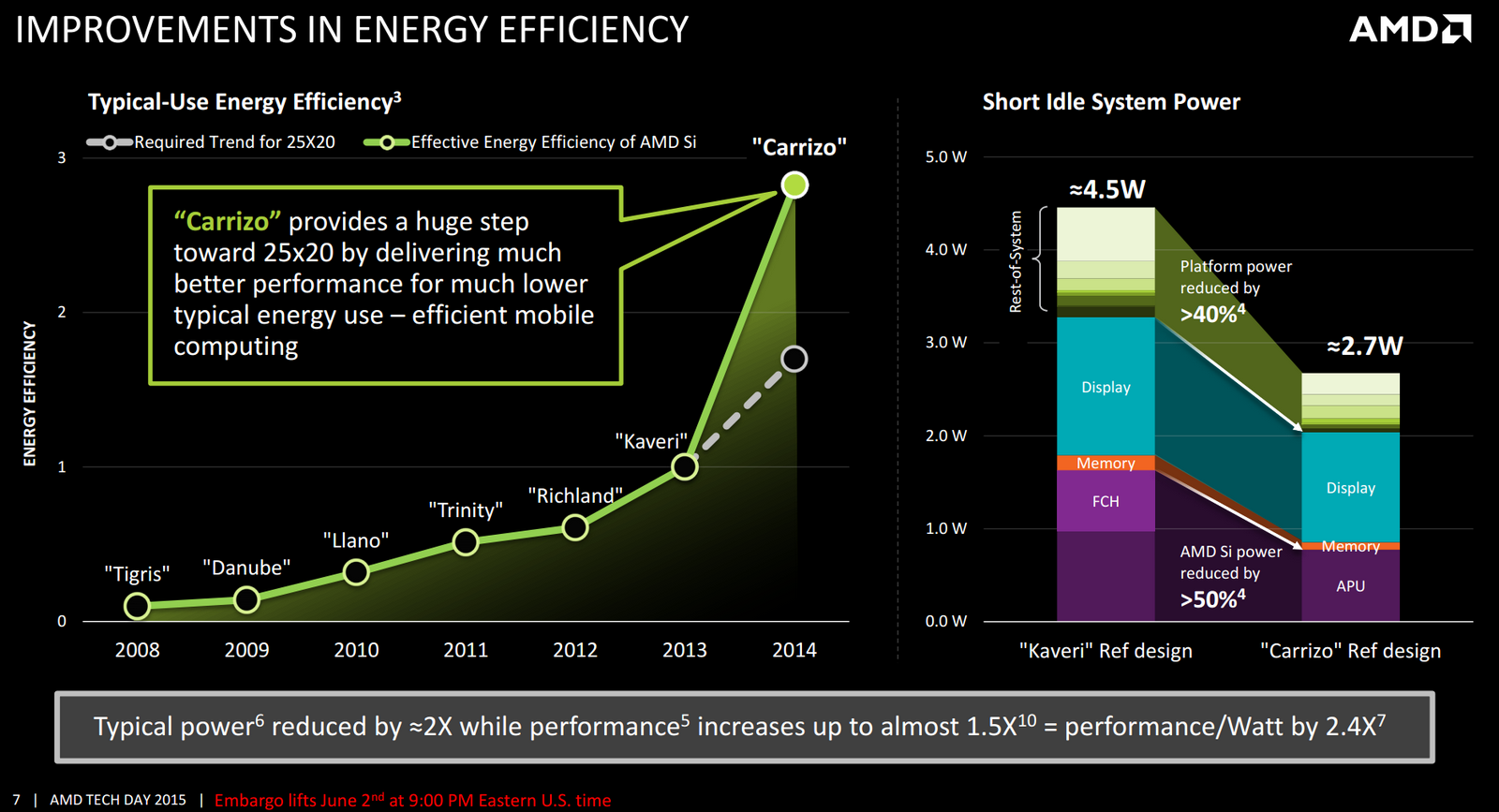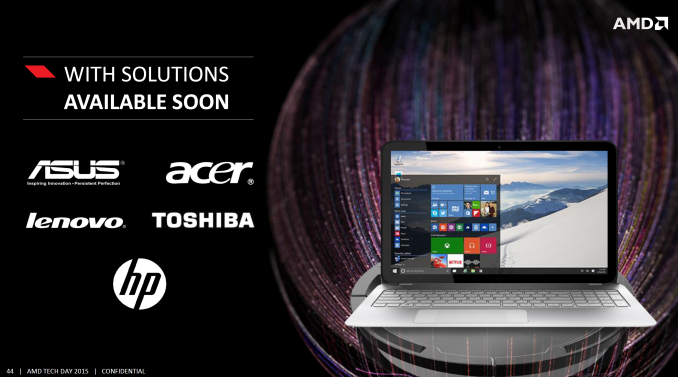Who Controls the User Experience? AMD’s Carrizo Thoroughly Tested
by Ian Cutress on February 4, 2016 8:00 AM ESTHow to Iterate Through Design
While AMD’s Carrizo is still based on this Bulldozer design, it represents the fourth iterative update, called Excavator, which is now produced at the 28nm process node compared to the 32nm original design. At each juncture from Bulldozer (rev1) through Piledriver (rev2) and Steamroller (rev3) to Excavator (rev4), AMDs goal has been the same as most other semiconductor manufacturers - produce a list of fixes that provide the most benefit for the least amount of time, then work through that list. This is not an uncommon procedure for iterative updates, and in itself retains the logical thought of improving the design as much as possible.
What this method perhaps misses are the bigger leaps in design philosophy where shifting fundamental paradigms can have a bigger impact on key properties of the product, but these changes in philosophy often carry the burden of increased risk and cost, where failure is seen as a waste of resources. Nevertheless, the Excavator core and the Carrizo design, according to AMD, implements a significant number of fundamental paradigm shifts compared to previous revisions, and as a result Carrizo behaves differently in a large number of key metrics. The base design underneath is still inherently the Bulldozer concept, however the 'skunkworks' style adjustments, according to AMD, significantly improve the power consumption, the single core performance and the potential battery life over previous AMD processor designs in mobile segments. All current gains on this design have only come from AMD, lacking independent verification.
For a more detailed look at AMD's Excavator design, with high density libraries and power management, read our run down of Carrizo's technology from our launch article here.
Gaining OEM Support
Aside from the processor itself, the image of AMD based devices, especially in the mobile segment, is not overly positive. As mentioned above, there are two sides to this story - original equipment manufacturers whom use AMD processors in their designs have to be confident that it will provide a level of performance suitable for the experience they expect the consumer to have. Similarly, the end user must also receive a platform that benefits the price point purchased and retains a level of quality consistent with providing a good experience. Former poor experiences can be a heavily influence in future purchasing decisions, and those with a negative opinion require a fundamental design change or significant external recommendations in order to make a change against a gut feeling. If a user keeps getting a poor design, regardless of which side of the fence is responsible (or both), both will be negatively affected, and sometimes one more than the other.
This applies to both consumers and business users, the latter of which is often down to individuals at companies making recommendations based on brand and business sense. If a business buyer insists on Dell, for example due to a long term support contract, they will source the most appropriate Dell device out of the range based on research and that gut feeling. In order for a semiconductor company to be competitive in this space, they need to work closely and extensively with the business OEMs to build devices that facilitate the experiences required with a level of industrial design that enables the appropriate experience. It is not difficult to search online for details of users that are disgruntled with devices from both Intel and AMD, particularly in areas such as industrial design of the device, performance, battery life, temperature and quality.
While Intel has a number of arms with partners based on the success of the Core architcture over the last decade, AMD’s stable of partners is not so large. AMD has three top tier partners – HP, Lenovo and Toshiba – all of whom are represented in this report. Like many other notebook manufacturers in the industry, all of these three are well known for some models but hounded on others, especially those at the bottom of the price stack or due to unique sets of security principles. As mentioned previously, HP focuses a lot on the Enterprise space with items like the Elitebook line, but if personal experience is anything to go by, consumer use of Elitebooks has declined. Toshiba meanwhile suffers from the race-to-the-bottom syndrome where sometimes a simple $30 upgrade can make the difference, and Lenovo’s recent software issues have been well documented. AMD works with these three partners the most, such that when they score a big contract (such as 30,000 units with HP for Dr. Pepper/Snapple) it is actually a big contract for AMD.












175 Comments
View All Comments
Gadgety - Sunday, February 7, 2016 - link
So AMD's marketing and distribution strategy is a failure. The way it's described it would seem consumers specifying their own PCs would be a away around the dominant logic determined by the existing channels. With today's production technology tailor made products on demand should be possible.The other thing I don't get, is why doesn't AMD release a desktop Carrizo 4K capable APU for the FM2+ platform? Do they want to help the motherboard manufacturers sell more motherboards once the new AM4 socket APU:s are out in 2017, or do they want to sell their own existing products?
JMC2000 - Sunday, February 7, 2016 - link
I think it's more along the lines of having an installed base of AM4 boards before any Zen-based APUs roll out.It is possible that if the Athlon X4 845 sells well, AMD could release a full Carrizo part on FM2+.
AlB80 - Sunday, February 7, 2016 - link
What is discrete graphic chip in Lenovo?512sp GCN1.2.... I suspect that this combination is unreal.
Jamesiii - Sunday, February 7, 2016 - link
I have actually ordered Dell's AMD A8-8600P. It is intended as a media machine with the selling points being the low power equating to quiet and the 4K capability. The one thing I did notice is that he does have the Single Channel DDR3L 1600MHz memory. There is no indication on if it unlocks the watts to 35, but I have my doubts given the choice of RAM.I will know more when I get it on Thursday and will update if anyone is still view this thread. But, at $380.00 it is not a bad choice for a media machine.
tygrus - Sunday, February 7, 2016 - link
OBM (the brands) bid for designs by the ODM's based on the design cost and the expected volume. I high cost Intel design can be made profitable by the expectation of very high volumes. Even the most popular AMD design is expected to sell fewer than a low-volume Intel design. Business limitations and commercial forces bias the system towards Intel. Intel also have deeper pockets to sponsor/partner/subsidise designs to make them Intel exclusive. From manufactures to distributors to retail, Intel penalise (withdraw discounts/subsidies) anyone who lets AMD gain market share (many limited to <10%) and limit the use of the "best" designs for AMD (forced to sell only A4 & A6 instead of A8 or better, limit battery and other features so Intel always looks better). The "Intel brakes" applied to AMD limits their opportunities and potential earnings. This has limited the AMD R&D spending and forced AMD to stay behind in some aspects. It's amazing what AMD has done with 28nm but think of the advantage they could have had with 22nm and 14nm if successful achieved much earlier (no more than 9months after Intel).every1hasaids - Monday, February 8, 2016 - link
I owned (owned being the operative word there) a Y700 with the AMD Carrizo FX8800P and can attest to the fact that the cooling solution and probably several other pieces of that device reviewed in this article are not the same design as what is available on the market in the US. There is a known issue of Lenovo skimping on the VRMs on the AMD Y700 which results in heavy throttling taking place. I couldn't play any game for more than 15 minutes before heavy throttling would occur. The data gathered from the review sample in this article should not be associated with the available product on the market. There appears to also be an FX-8700P variant of the Y700 out there however I cannot find any documentation of the existence of this device on Lenovo's site. Needless to say that I returned that laptop due to the significant throttling problems. I wish this site of some other site could get their hands on one of the FX-8800P Y700 laptops available in the US and put it through testing to reveal the problems with the unit. I'm guessing that they intend on releasing a Carrizo-L version of that laptop with the same motherboard which is why the VRMs are not up to the task of the 35w Carrizo and the added consumption of the dedicated graphics chip.Why are there no units out there that can handle the 35w TDP Carrizo and a dedicated graphics card!?!?!?! It would be a great alternative to the Intel/Nvidia gaming notebook monopoly.
I'm hoping Zen/Polaris will actually see some adoption from OEMs and maybe AMD could even get involved in assisting proper implementation of their products so that the negative stigma could get nullified.
Jamesiii - Monday, February 8, 2016 - link
The FX-8700P would more properly be called an A10-8700P. It sounds like a bit of marketing if they are using the FX handle.On gaming sites people are suggesting you turn off AMD's Turbo Core when gaming to avoid the FPS jumping up and down and overclock the processors. Overclocking a laptop is dicey at best though.
Malih - Monday, February 8, 2016 - link
maybe Microsoft should start making an AMD Surface laptop if they want good competition to drive PC SalesMarcelo Viana - Monday, February 8, 2016 - link
I just don't understand why in a comparison carrizo vs intel you didn't take out the intel chips memory in order to both have 1 channel memory, so do a benchmark for us in a same condition.The entire article show that intel offering has OEMs given what intel chips need, so the point in comparing carrizo vs intel is the chip itself not platform, since AMD has no platform at all.
Elensar286 - Monday, February 8, 2016 - link
That's a large focus of this article, though. The whole point was an investigation in to the implementation of Carrizo APUs by the OEM. It's highlighting exactly how like you said, the OEM platform, is hindering the potential of Carrizo processors.